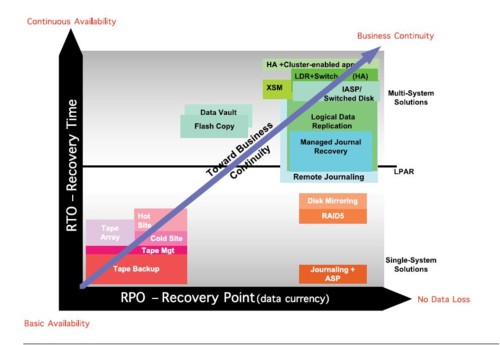Dramatic changes in cost and ease of use have made downtime-reducing technologies more accessible.
Editor's Note: This article is an introduction to the white paper "Five Reasons Why Smaller Organizations Should Consider High Availability."
Until recently, IBM System i high availability solutions were reserved mostly for large enterprises. Now that high availability is dramatically easier to use and less expensive to own and manage, the landscape has changed. Thousands of small and mid-sized companies can now afford the "luxury" of real-time, offsite data protection, as well as rapid and complete data recovery.
Fortunately, this shift is occurring just as downtime is causing more of a disruption and expense to businesses than ever before. With technology costs dropping and downtime costs skyrocketing, companies of all sizes have a huge incentive to evaluate System i high availability technology.
This article provides a review of the core causes and costs of both planned and unplanned downtime and then includes a detailed discussion of current options for high availability and disaster recovery solutions. Most important, you will see why true high availability (HA) and disaster recovery (DR) protection are now within reach of even the smallest of businesses.
RPO Versus RTO
Before looking more closely at the cost factors of HA—and why each has changed so significantly—it is helpful to first understand the concepts of recovery time objective (RTO) and recovery point objective (RPO).
The graph in Figure 1 shows a variety of common System i business continuity technologies in which one axis indicates the time it takes to recover data after a failure/disaster (the RTO) and the other axis indicates the completeness of data that is ultimately recovered (the RPO).

Figure 1: This graph represents RPO and RTO and the spectrum of System i DR solutions/strategies.
At the low end of the DR spectrum is tape backup (basic availability) and at the high end is HA, a process more technically known as logical data replication-plus-switchover (LDR+Switch), which rapidly moves users and processes to a fully mirrored secondary server in order for it to assume all or most of the functions of the production server.
Unfortunately, the perception of many mid-size and small companies is that HA technology is so much more expensive than basic disaster recovery protection that it is considered "out of reach" in terms of both cost and complexity. But, in line with most other computing technologies, the range of options between the most basic DR protection and the high-end, fault-tolerant, enterprise-scale solutions has increased, and, overall, the cost of all the options has come down—radically in some cases.
Factors of High Availability Costs
High availability is certainly not "cheap" when you consider all of the components that are needed. What has changed is how the cost of each of these factors—each for its own reasons—has dropped. Here are the major components that contribute to the cost of an HA solution:
- Hardware
- Communication bandwidth
- High availability software
- High availability management
So what has changed? Why should you re-consider whether you can justify investment in a true high availability solution?












 Business users want new applications now. Market and regulatory pressures require faster application updates and delivery into production. Your IBM i developers may be approaching retirement, and you see no sure way to fill their positions with experienced developers. In addition, you may be caught between maintaining your existing applications and the uncertainty of moving to something new.
Business users want new applications now. Market and regulatory pressures require faster application updates and delivery into production. Your IBM i developers may be approaching retirement, and you see no sure way to fill their positions with experienced developers. In addition, you may be caught between maintaining your existing applications and the uncertainty of moving to something new. IT managers hoping to find new IBM i talent are discovering that the pool of experienced RPG programmers and operators or administrators with intimate knowledge of the operating system and the applications that run on it is small. This begs the question: How will you manage the platform that supports such a big part of your business? This guide offers strategies and software suggestions to help you plan IT staffing and resources and smooth the transition after your AS/400 talent retires. Read on to learn:
IT managers hoping to find new IBM i talent are discovering that the pool of experienced RPG programmers and operators or administrators with intimate knowledge of the operating system and the applications that run on it is small. This begs the question: How will you manage the platform that supports such a big part of your business? This guide offers strategies and software suggestions to help you plan IT staffing and resources and smooth the transition after your AS/400 talent retires. Read on to learn:
LATEST COMMENTS
MC Press Online